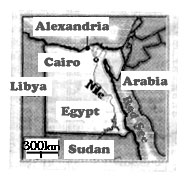The discovery of the remnants of a huge cemetery, known as the Ptolomean Necropolis in the Gabbari area in Alexandria, Egypt, has been hailed as a major success by archaeologists.
The cemetery, dating back to Ptolomean times, two centuries B-C. was an important symbol for the inhabitants of Alexandria who were used to bury their dead according to a certain ritual. For instance, they would have a meal sitting on stone seats after placing their dead in niches and putting a coin in their mouth to pay for their passage on the Styx, the river of hell.

Necropolis was situated in the western part of the city not far from the celebrated 120 metre-high light-house, one of the seven marvels of the world while all the scholars of the Mediterranean region would pay a visit to the no less famed library nearby.
Buried under the modern part of Alexandria, it has been unearthed during the construction of a bridge aimed at easing the huge traffick of lorries. A carterpillar dug through the ceiling of an imposing tomb containing 150 bodies and archaeologists called upon the site and construction works were suspended.
Funeral dining rooms, many wine jars and paintings were discovered in this huge cemetery believed to have built over a kilometre-long area and where thousands of dead were buried. It also contained embalming rooms and gardens. All the dead are believed to be Greek citizens as Alexander the Great had not granted a city citizenship to Egyptians while Jews had been allowed to occupy the eastern part of Alexandria.
Most of the tombs were found intact over two levels and archaeologists have been allowed to pursue their diggings for at least five months. Their dream is to find the tomb of Alexander the Great himself though it is believed that it lies somewhere else under a cinema house which would have to be destroyed in order to enable them to investigate this spot.